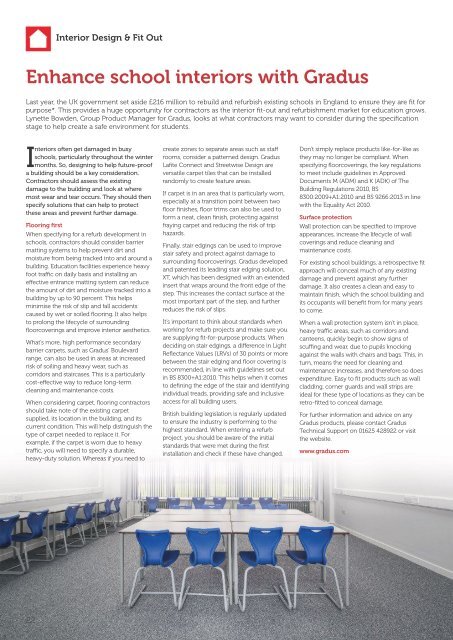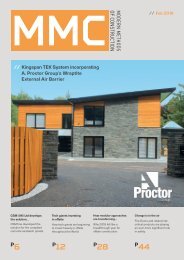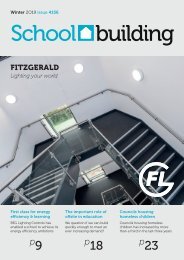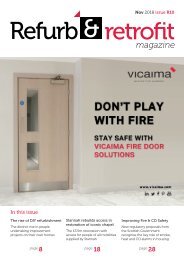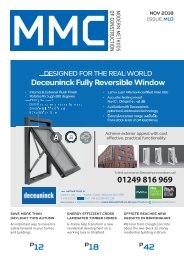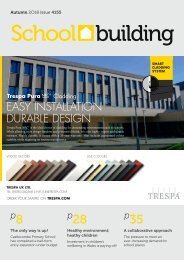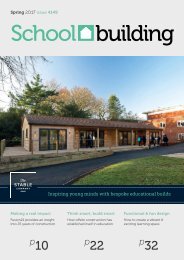You also want an ePaper? Increase the reach of your titles
YUMPU automatically turns print PDFs into web optimized ePapers that Google loves.
Interior Design & Fit Out<br />
Enhance school interiors with Gradus<br />
Last year, the UK government set aside £216 million to rebuild and refurbish existing schools in England to ensure they are fit for<br />
purpose*. This provides a huge opportunity for contractors as the interior fit-out and refurbishment market for education grows.<br />
Lynette Bowden, Group Product Manager for Gradus, looks at what contractors may want to consider during the specification<br />
stage to help create a safe environment for students.<br />
Interiors often get damaged in busy<br />
schools, particularly throughout the winter<br />
months. So, designing to help future-proof<br />
a building should be a key consideration.<br />
Contractors should assess the existing<br />
damage to the building and look at where<br />
most wear and tear occurs. They should then<br />
specify solutions that can help to protect<br />
these areas and prevent further damage.<br />
Flooring first<br />
When specifying for a refurb development in<br />
schools, contractors should consider barrier<br />
matting systems to help prevent dirt and<br />
moisture from being tracked into and around a<br />
building. Education facilities experience heavy<br />
foot traffic on daily basis and installing an<br />
effective entrance matting system can reduce<br />
the amount of dirt and moisture tracked into a<br />
building by up to 90 percent. This helps<br />
minimise the risk of slip and fall accidents<br />
caused by wet or soiled flooring. It also helps<br />
to prolong the lifecycle of surrounding<br />
floorcoverings and improve interior aesthetics.<br />
What’s more, high performance secondary<br />
barrier carpets, such as Gradus’ Boulevard<br />
range, can also be used in areas at increased<br />
risk of soiling and heavy wear, such as<br />
corridors and staircases. This is a particularly<br />
cost-effective way to reduce long-term<br />
cleaning and maintenance costs.<br />
When considering carpet, flooring contractors<br />
should take note of the existing carpet<br />
supplied, its location in the building, and its<br />
current condition. This will help distinguish the<br />
type of carpet needed to replace it. For<br />
example, if the carpet is worn due to heavy<br />
traffic, you will need to specify a durable,<br />
heavy-duty solution. Whereas if you need to<br />
create zones to separate areas such as staff<br />
rooms, consider a patterned design. Gradus<br />
Lafite Connect and Streetwise Design are<br />
versatile carpet tiles that can be installed<br />
randomly to create feature areas.<br />
If carpet is in an area that is particularly worn,<br />
especially at a transition point between two<br />
floor finishes, floor trims can also be used to<br />
form a neat, clean finish, protecting against<br />
fraying carpet and reducing the risk of trip<br />
hazards.<br />
Finally, stair edgings can be used to improve<br />
stair safety and protect against damage to<br />
surrounding floorcoverings. Gradus developed<br />
and patented its leading stair edging solution,<br />
XT, which has been designed with an extended<br />
insert that wraps around the front edge of the<br />
step. This increases the contact surface at the<br />
most important part of the step, and further<br />
reduces the risk of slips.<br />
It’s important to think about standards when<br />
working for refurb projects and make sure you<br />
are supplying fit-for-purpose products. When<br />
deciding on stair edgings, a difference in Light<br />
Reflectance Values (LRVs) of 30 points or more<br />
between the stair edging and floor covering is<br />
recommended, in line with guidelines set out<br />
in BS 8300+A1:2010. This helps when it comes<br />
to defining the edge of the stair and identifying<br />
individual treads, providing safe and inclusive<br />
access for all building users.<br />
British building legislation is regularly updated<br />
to ensure the industry is performing to the<br />
highest standard. When entering a refurb<br />
project, you should be aware of the initial<br />
standards that were met during the first<br />
installation and check if these have changed.<br />
Don’t simply replace products like-for-like as<br />
they may no longer be compliant. When<br />
specifying floorcoverings, the key regulations<br />
to meet include guidelines in Approved<br />
Documents M (ADM) and K (ADK) of The<br />
Building Regulations 2010, BS<br />
8300:2009+A1:2010 and BS 9266:2013 in line<br />
with the Equality Act 2010.<br />
Surface protection<br />
Wall protection can be specified to improve<br />
appearances, increase the lifecycle of wall<br />
coverings and reduce cleaning and<br />
maintenance costs.<br />
For existing school buildings, a retrospective fit<br />
approach will conceal much of any existing<br />
damage and prevent against any further<br />
damage. It also creates a clean and easy to<br />
maintain finish, which the school building and<br />
its occupants will benefit from for many years<br />
to come.<br />
When a wall protection system isn’t in place,<br />
heavy traffic areas, such as corridors and<br />
canteens, quickly begin to show signs of<br />
scuffing and wear, due to pupils knocking<br />
against the walls with chairs and bags. This, in<br />
turn, means the need for cleaning and<br />
maintenance increases, and therefore so does<br />
expenditure. Easy to fit products such as wall<br />
cladding, corner guards and wall strips are<br />
ideal for these type of locations as they can be<br />
retro-fitted to conceal damage.<br />
For further information and advice on any<br />
Gradus products, please contact Gradus<br />
Technical Support on 01625 428922 or visit<br />
the website.<br />
www.gradus.com<br />
22


